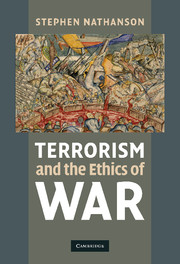Book contents
- Frontmatter
- Contents
- Acknowledgments
- Introduction
- PART I TERRORISM: WHAT'S IN A NAME?
- 1 The problem of defining terrorism
- 2 Defining terrorism
- 3 What makes terrorism wrong?
- 4 Innocence and discrimination
- 5 “Who dun it” definitions of terrorism
- Conclusion: taking stock
- PART II WHY MORAL CONDEMNATIONS OF TERRORISM LACK CREDIBILITY
- PART III DEFENDING NONCOMBATANT IMMUNITY
- PART IV HOW MUCH IMMUNITY SHOULD NONCOMBATANTS HAVE?
- Conclusion: terrorism and the ethics of war
- Bibliography
- Index
5 - “Who dun it” definitions of terrorism
Published online by Cambridge University Press: 05 June 2012
- Frontmatter
- Contents
- Acknowledgments
- Introduction
- PART I TERRORISM: WHAT'S IN A NAME?
- 1 The problem of defining terrorism
- 2 Defining terrorism
- 3 What makes terrorism wrong?
- 4 Innocence and discrimination
- 5 “Who dun it” definitions of terrorism
- Conclusion: taking stock
- PART II WHY MORAL CONDEMNATIONS OF TERRORISM LACK CREDIBILITY
- PART III DEFENDING NONCOMBATANT IMMUNITY
- PART IV HOW MUCH IMMUNITY SHOULD NONCOMBATANTS HAVE?
- Conclusion: terrorism and the ethics of war
- Bibliography
- Index
Summary
If I have succeeded so far, readers should now accept the definition I have defended. Before fully accepting it, however, readers should understand that the definition differs from the definitions given by many experts on terrorism and clashes with widespread beliefs about terrorism. In this chapter, I will show why the definition should be accepted in spite of these clashes and departures.
AGENT-FOCUSED DEFINITIONS
I claim that terrorist acts have four features. They:
1. are acts of serious, deliberate violence or credible threats of such acts;
2. are committed in order to promote a political or social agenda;
3. generally target limited numbers of people but aim to influence a larger group and/or the leaders who make decisions for the group;
4. intentionally kill or injure innocent people or pose a threat of serious harm to them.
Someone could accept all the features on the list as defining characteristics of terrorism but reject the definition because it fails to include a crucial feature of terrorist acts. According to both ordinary usage and the language of scholars, the word “terrorism” only applies to actions done by certain types of people or groups. This “agent-focused” conception of terrorism takes different forms. The crudest, most blatantly biased form defines “terrorism” as violence by groups who are “our” enemies. A less crude but still biased form limits terrorist acts to violence carried out by non-governmental groups. This view implies that the word “terrorism” cannot be applied to violence carried out by governments.
- Type
- Chapter
- Information
- Terrorism and the Ethics of War , pp. 59 - 72Publisher: Cambridge University PressPrint publication year: 2010



